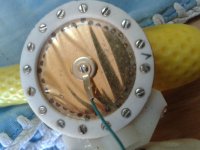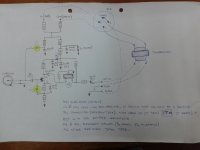Hi!!
I friend of mine brought me an unbranded condenser mic to repair it.
So, I opened and I saw the diaphragm been loosy, like waves on the surface of water.. heres a pic:

So, I wish to know if is there the posibility of fix it or raplace it.. and where to buy some replacement capsule (ebay?)
By the way.. the mic has evidence of someone have been opened and repair it..
I friend of mine brought me an unbranded condenser mic to repair it.
So, I opened and I saw the diaphragm been loosy, like waves on the surface of water.. heres a pic:

So, I wish to know if is there the posibility of fix it or raplace it.. and where to buy some replacement capsule (ebay?)
By the way.. the mic has evidence of someone have been opened and repair it..
Routed schematic
Here again..
I found on ebay, (in china) a replacement for the capsule. Is on the way..
So, I was looking at the preamp circuit of the mic.. I never read something about condenser mics.. so I'm newby on this..
I have routed the circuit.. And I draw a schematic.. There are some tasks that I did not understand very well... So, could you tell me if this circuit its valid?

The transistor T1 has a pin grounded... this makes me think that is a bjt with hes emiter grounded.. what do you think?
Here again..
I found on ebay, (in china) a replacement for the capsule. Is on the way..
So, I was looking at the preamp circuit of the mic.. I never read something about condenser mics.. so I'm newby on this..
I have routed the circuit.. And I draw a schematic.. There are some tasks that I did not understand very well... So, could you tell me if this circuit its valid?

The transistor T1 has a pin grounded... this makes me think that is a bjt with hes emiter grounded.. what do you think?
More likely a PNP emitter follower, as a common emitter stage without any feedback would distort a lot.
If it is a "normal" rather than an electret condenser microphone, C1 is probably a resistor with a value of the order of 1 Gohm. The value of resistor C2 is probably also in that order of magnitude.
If it is a "normal" rather than an electret condenser microphone, C1 is probably a resistor with a value of the order of 1 Gohm. The value of resistor C2 is probably also in that order of magnitude.
Thanks Marcel to Drop some light on this!
It is a 34 mm capsule.
Before I opened the mic I made a proove on the mixer. The output was very very weak. Do you think the bad capsule is the cause of the almost nule output?
It is a 34 mm capsule.
Before I opened the mic I made a proove on the mixer. The output was very very weak. Do you think the bad capsule is the cause of the almost nule output?
Thanks Marcel to Drop some light on this!
It is a 34 mm capsule.
Before I opened the mic I made a proove on the mixer. The output was very very weak. Do you think the bad capsule is the cause of the almost nule output?
It's obvious from the damage to the screw heads that someone attempted to "repair" the diaphragm. I don't think this can be done correctly without a factory jig or equivalent. "C1" (the correct R value) would provide bias for the capsule without it there will be nil output.
Last edited:
It could be the capsule, a loose bias resistor (C1), something in the amplifier or a mixer / microphone preamplifier with a lower phantom supply voltage than what the microphone was designed for.
The capsule obviously needs replacement. If replacing it doesn't help, use a multimeter with a 10 kohm series resistor (to ensure the loading by the meter doesn't cause instability) to check the amplifier's bias voltages. With a normal DMM you won't be able to measure the gate voltage of the JFET or the voltage across the capsule; the 1 Mohm to 10 Mohm input resistance of a typical DMM is practically a short circuit compared to the 1 Gohm or so bias resistors.
By the way, if you find that the mike sometimes works and sometimes doesn't, it can be an open gate bias resistor of the JFET. I saw that once on an AKG C452; with disconnected resistor the gate can float to any voltage between ground and supply.
The capsule obviously needs replacement. If replacing it doesn't help, use a multimeter with a 10 kohm series resistor (to ensure the loading by the meter doesn't cause instability) to check the amplifier's bias voltages. With a normal DMM you won't be able to measure the gate voltage of the JFET or the voltage across the capsule; the 1 Mohm to 10 Mohm input resistance of a typical DMM is practically a short circuit compared to the 1 Gohm or so bias resistors.
By the way, if you find that the mike sometimes works and sometimes doesn't, it can be an open gate bias resistor of the JFET. I saw that once on an AKG C452; with disconnected resistor the gate can float to any voltage between ground and supply.
Phantom power
Hi guys!
Here again...
Do you think that this mic its rated to work with a +48 V phantom power supply?
Those electrollityc caps rated at 25V scared me a little...
Edited: the mic dosn't have any brand market on it... I'l take some pics this evening.
Hi guys!
Here again...
Do you think that this mic its rated to work with a +48 V phantom power supply?
Those electrollityc caps rated at 25V scared me a little...
Edited: the mic dosn't have any brand market on it... I'l take some pics this evening.
Last edited:
Hi guys!
Here again...
Do you think that this mic its rated to work with a +48 V phantom power supply?
Most of the cheap Chinese capsule mics are, the caps see a lot less than that after the supply is divided to power the FET.
Could the diodes marked 1N4148? on your schematic be Zeners?
I have to look at it with magnifing glasses to see hes mark on they. They are SMD type.
Could the diodes marked 1N4148? on your schematic be Zeners?
Yesterday I looked with magnifing glasses.. They don't have any mark on their bodys..
The cathode mark is blue-purple color.. and a thin band of silver color at the middle of the body..
It's a pity you can't confirm it by looking at them, but considering the way they are connected, chances are that they are Zeners that shunt stabilize the supply of the amplifier and protect the electrolytic capacitors when you connect a 48 V phantom supply.
Thanks for your anwsers!
Yesterday arrived the new capsule..
tomorrow I'll conect to the mic and I'll cross my fingers..
Yesterday arrived the new capsule..
tomorrow I'll conect to the mic and I'll cross my fingers..
- Status
- Not open for further replies.
- Home
- General Interest
- Everything Else
- Capsule of condenser mic